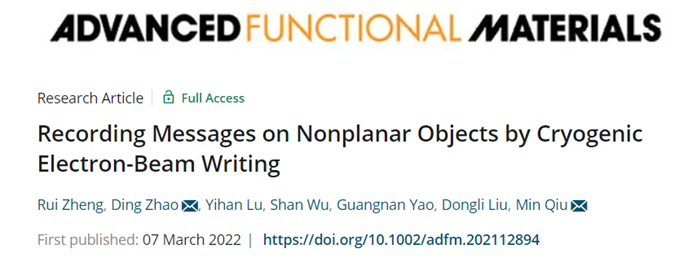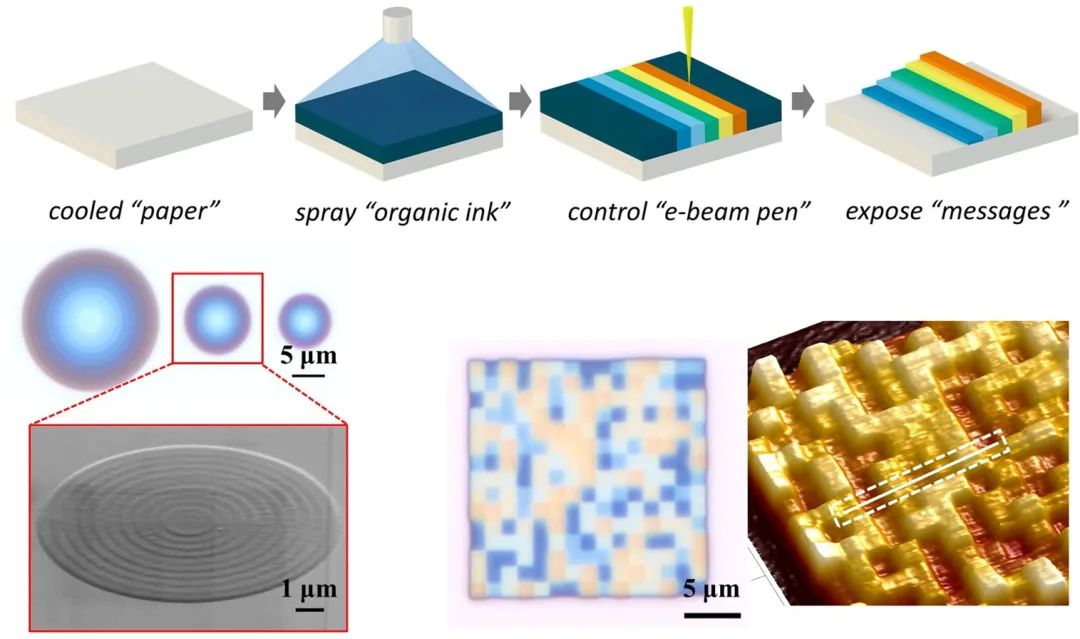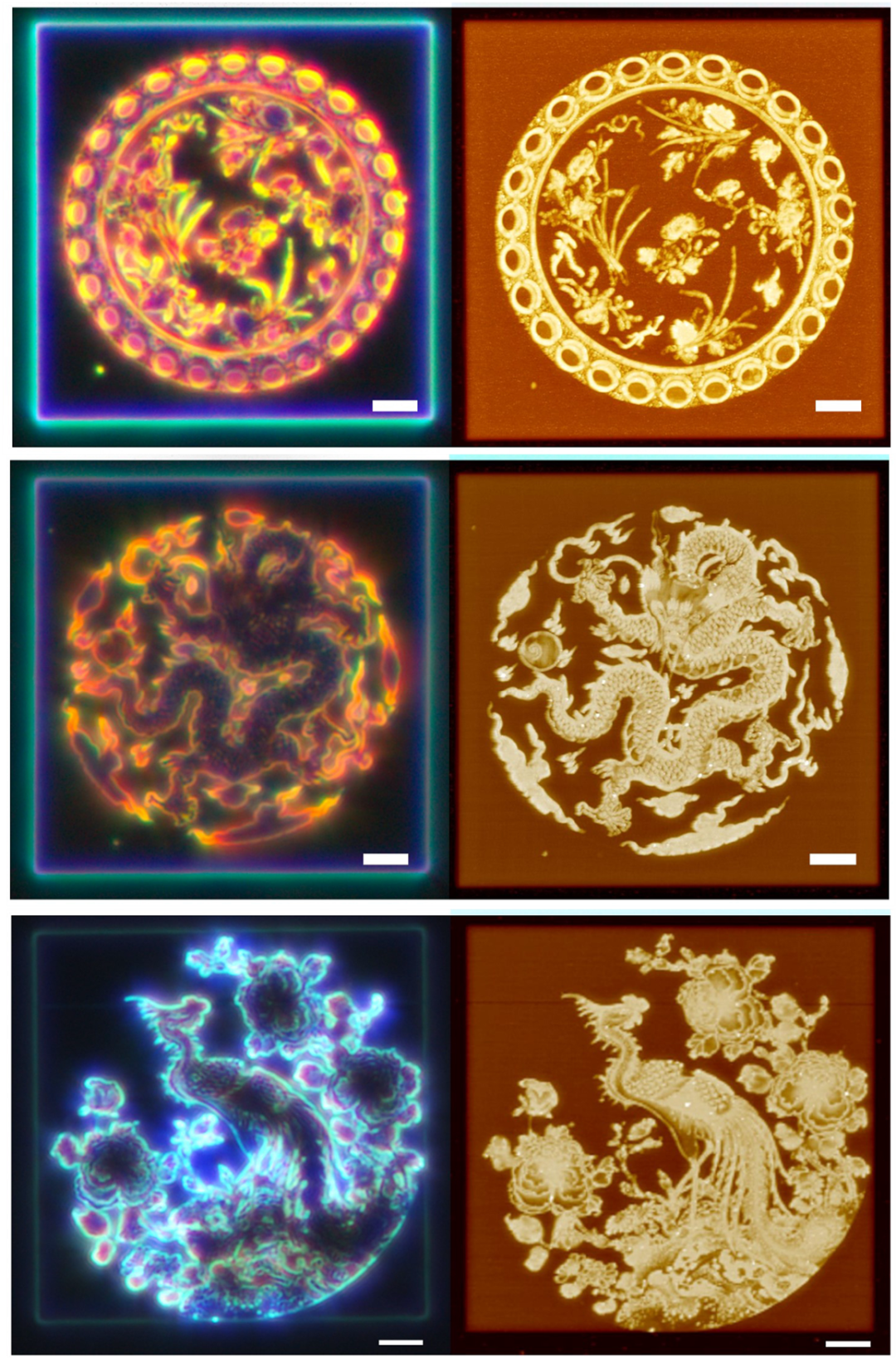The evolution of writing systems illustrates the development of information storage, as well as the development of the times. The simplest strategy to record more messages in a limited space is to employ smaller 'words'. Since Feynman published There's plenty of room at the bottom in 1959, many methods have been proposed for creating patterns or structures at microscopic scale, such as scanning probe lithography towards atomic resolution fabrication
Recently, the Min Qiu's group at Westlake University published an article online on Advanced Functional Materials titled "Recording Messages on Nonplanar Objects by Cryogenic Electron-Beam Writing". In this article, they report a new method to record messages. Sub-10 nm accuracy can be obtained in an eleven-step structure. A quinary pattern is written to show that the information storage capacity can reach 1013 bits per cm3. High-resolution painting is also achieved by importing grayscale images. Attributed to the flexibility of ice formation, the process can be applied on non-planar substrates such as an aluminum tape or a silver wire

Paper link: https://doi.org/10.1002/adfm.202112894
The recording process starts with ice deposition to coat a uniform ice resist onto a precooled sample. The resist is selectively exposed by a focused e-beam, where different areas correspond to different electron doses, thus different heights of structures. After heating up the sample to room temperature, unexposed ice sublimates, desired 3D patterns remain.
Using discrete dose distribution, the research team write an eleven-step structure with a height difference of sub-10 nm accuracy. After that, they also fabricated a "QR code" array with 15 rows, 15 columns and 5 different three-dimensional thicknesses. The side length of the smallest square unit is about 500 nm, which results in an information storage density of 1 bit / (0.5 μm × 0.5 μm × 0.2 μm) = 20 Tbit cm–3 for a single layer. The above calculation is for the binary situation. If quinary is used, the amount of information that can be stored in each unit is log25 bits, so the actual amount of information stored in this array is much more.

Writing process (top), the resulting eleven-step structure (bottom left) and "QR code" array (bottom right)
To create complex structures containing slope features, writing with imported grayscale images is a simple and efficient way. Taking the slope structures for example, 256 grayscale values correspond to 256 step heights. The research team successfully fabricated different slopes with horizontal lengths ranging from 2.4 μm to 24 μm. Numerous step heights ensure the fitting accuracy of the inclined structure, making it finally show good continuity and smoothness.

Top view of a single slope structure (left) and line profiles of different slope structures (right)
An art painting can also be imported for recording. A sparkling appearance appears in dark-field optical imaging, where readers can get an ingenious artistic conception beyond the original. The research team take advantage of this feature to reinterpret the exquisite paintings at the micro and nano scales. For example, the results of Qing Dynasty artwork"Plate with Talismans for Duanwujie (Dragon Boat Festival)", a collection in the Art Institute of Chicago, allow us to re-experience the different styles of artworks from a new perspective.

“Plate with Talismans for Duanwujie (Dragon Boat Festival)” (top), “Dish with Five-Clawed Dragon” (center), and “Ruby-Back Dish with Phoenix” (bottom). Scale bars are 4 μm. The original images are at the Art Institute of Chicago.
Compared with traditional methods, the cryogenic electron-beam writing can be performed on nonplanar objects. For example, on an aluminum tape, metal particles, etc., this method can draw customized patterns for anti-counterfeiting. Even on a metal wire with a diameter of 30 μm which is thinner than a human hair, the logo of Westlake University covers the surface well, demonstrating the ability of this method to store three-dimensional information on any surface.

Cryogenic e-beam writing of the Westlake University logo on nonplanar substrates.
Professor Min Qiu's group has not only realized the fabrication of microscale structures with sub-10 nm accuracy through cryogenic electron-beam writing, but also realized recording complex patterns on any surface for information storage, anti-counterfeiting, etc. In the future, benefiting from the development of massively parallel approaches, this method together with electron-beam lithography can be scaled towards high-volume production.
Reprinted from: Westlake University Engineering college SOE

